Io (Jupiter)
Contents
 Galileo Spacecraft true color image of Io / nasa.gov
Galileo Spacecraft true color image of Io / nasa.govSince its discovery in 1609, it was believed that Io was a dead boring world with little interest until a strange plume showed continuously on its surface. Further research identified this plume as a volcanic eruption which prompted scientist to rethink their idea and to observe Io a little closer. Then in 1979, Nasa's Voyager Spacecraft, during a flyby, discovered something they did not expect. What they found was a very active and alive planetary object that host the largest number of active volcanoes in the solar system.
Discovery
Although Galileo Galilei is accredited as the discoverer of Io, in the beginning, there was debate as to the discoverer between Galilei and Simon Marius. According to Marius, he discovered Io and the other Galilean moons a week before Galilei. The trouble with the claim is that not only did Galilei publish his findings first but that Marius was going off of a Julian Calendar on the date of December 29, 1609, which is January 8, 1609, in the Gregorian Calendar which is what Galilei was using and Galilei discovered Io on January 7, 1609. So either way, Galilei saw Io first.
Position to Jupiter
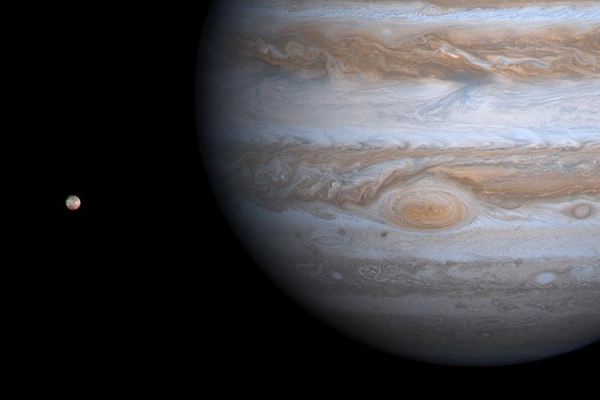 Jupiter Eye to Io / nasa.gov
Jupiter Eye to Io / nasa.govIo is Jupiter's innermost moon sitting at only 421,700 km (262,000 miles) from the planet. It orbits at an inclination of 0.05° and takes approximately only 42 hours to complete its rotation. It's fast rotation and nearness to Jupiter has a huge impact on its magnetic field. Generating approximately 400,000 volts of electricity from its fast orbit, it interacts with Jupiter's tidal forces and magnetic field making it much larger then it would original have been on its own.
Internal Structure
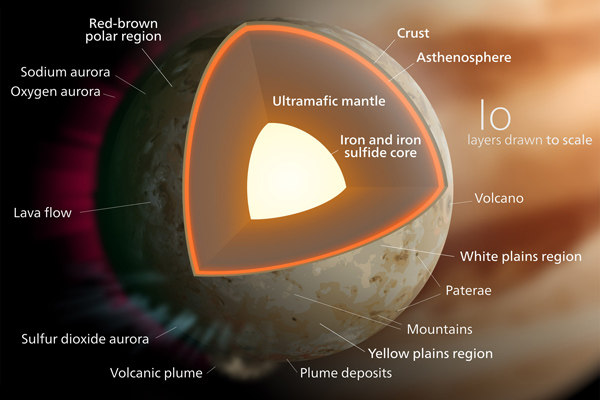 Model of the possible interior composition of Io / wikipedia.org
Model of the possible interior composition of Io / wikipedia.orgIo's internal structure is very similar to terrestrial planets in that it consist of a solid iron core surrounded by silicate rock taking up 20% of the planet's total mass and is estimated to be approximately 350-650 km (220-400 miles) in radius. It has the highest density of any other moon in our solar system at 3.55 gm/cm3.
It is believed that its core may actually be similar to Earth's giving it the ability to produce and maintain its own magnetic field. It is also believed based on data collected from previous missions that there may actually be an ocean of magma beneath the surface approximately 50 km (31 miles) down and takes up approximately 10% of the moon's mantle.
Surface/Geography
 Io's surface map / nasa.gov
Io's surface map / nasa.govAtmosphere/Climate
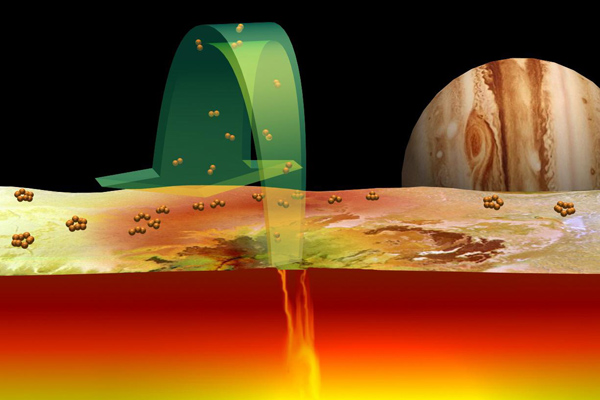 The Role of Sulfur in Io's Volcanoes / nasa.gov
The Role of Sulfur in Io's Volcanoes / nasa.govIf ever visiting Io, you would find it very dangerous to attempt to breathe within its atmosphere. Its surface being covered in active volcanos, the air on Io is both thin and poisonous consisting primarily of sulfur. There are no clouds, rain, or lightning on Io and what little wind comes from the constant erupting volcanoes on the surface. Io's atmosphere does not last long, however, the lack of gravity causes for its atmosphere to spill out into space with nothing to hold it down. The temperature on the moon's surface is estimated to be -130°C (-202°F) which leads to the existence of sulfur dioxide snowfields on its surface.
Exploration
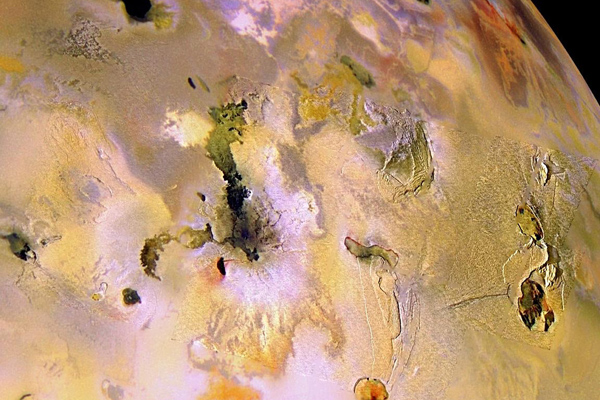 Ionian Mountains and Calderas / nasa.gov
Ionian Mountains and Calderas / nasa.govPioneer 10 was the first probe to enter the Jupiter system and observe Io. It observed that Io had an ionosphere which means it has a thin atmosphere estimating an atmosphere pressure of 0.3 to 3 nbar. Pioneer 11 visited the Io a year later and was the first spacecraft to send back images of Io. Between the two probes, data received showed that there was an interaction between Jupiter and Io's magnetic fields which created an effect called the Io flux tube.
In the late 1970's, the twin probes Voyager 1 and 2 did observations of Io during their flyby in the Jupiter system. Voyager 1 was the first to send back images of a large cloud near the polar regions. 9 more clouds were observed which prompted further investigation of the moon and the realization that volcanism existed on the surface.
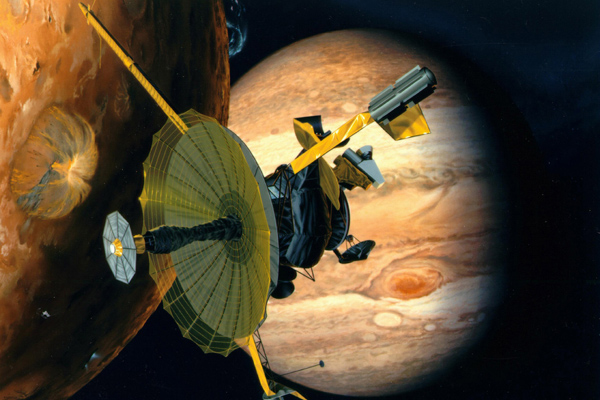 Artist's concept of Galileo at Io / nasa.gov
Artist's concept of Galileo at Io / nasa.govIn 1989, the Galileo spacecraft was sent to orbit Jupiter and observe the planet and its moons. Images from this spacecraft showed that Io had similarities to the inner planets of our solar system more so than the outer planetary objects in that it contained a differentiated large iron core. Data also showed that there was a strong possibility that Io created its own magnetic field which was an unusual trait for a moon.
A future proposed mission called the Io Volcanic Observer has been discussed to observe the volcanic activity but has yet to be initiated. If it goes through, the probe will explore Io's active volcanoes and their influence on the Jupiter system. This will be done by measuring the global heat flows caused by the volcanoes, observing Io's induced magnetic field, and temperatures of the lava on it's surface.
See also: All satellites and moons, Jupiter's satellites and moons, Jupiter, Objects
Video Gallery

-
 Explosive Io - Wonders of the Solar System
Explosive Io - Wonders of the Solar System
-
 Io's Underground Magma Ocean
Io's Underground Magma Ocean
-
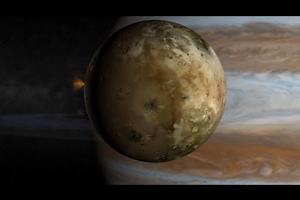 Jupiter's Moon Io
Jupiter's Moon Io
-
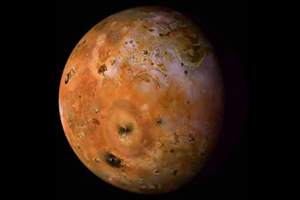 NASA Sound of Space - Jupiter's Moon Io
NASA Sound of Space - Jupiter's Moon Io